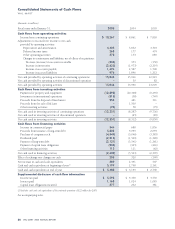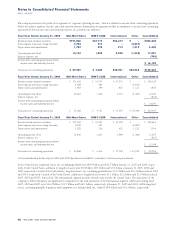Walmart 2005 Annual Report Download - page 41
Download and view the complete annual report
Please find page 41 of the 2005 Walmart annual report below. You can navigate through the pages in the report by either clicking on the pages listed below, or by using the keyword search tool below to find specific information within the annual report.
WAL-MART 2005 ANNUAL REPORT 39
Stock-based Compensation
The company recognizes expense for its stock-based compensation
based on the fair value of the awards that are granted. The fair value of
stock options is estimated at the date of grant using the Black-Scholes-
Merton option valuation model which was developed for use in esti-
mating the fair value of exchange traded options that have no vesting
restrictions and are fully transferable. Option valuation methods
require the input of highly subjective assumptions, including the
expected stock price volatility. Measured compensation cost is rec-
ognized ratably over the vesting period of the related stock-based
compensation award.
The fair value of the company’s stock options was estimated at the
date of the grant using the following assumptions:
2005 2004 2003
Dividend yield 1.1% 1.0% 0.7%
Volatility 23.2% 32.3% 32.1%
Risk-free interest rate 3.3% 2.8% 3.2%
Expected life in years 5.4 4.5 4.6
Weighted-average fair value
of options at grant date $11.39 $15.83 $15.67
Insurance/Self-Insurance
The company uses a combination of insurance, self-insured reten-
tion and self-insurance for a number of risks, including workers’
compensation, general liability, vehicle liability and the company-
funded portion of employee-related health care benefits. Liabilities
associated with these risks are estimated in part by considering
historical claims experience, demographic factors, severity factors
and other actuarial assumptions.
Depreciation and Amortization
Depreciation and amortization for financial statement purposes are
provided on the straight-line method over the estimated useful lives
of the various assets. Depreciation expense, including amortization
of property under capital leases for the years 2005, 2004 and 2003
was $4.3 billion, $3.7 billion and $3.2 billion, respectively. For
income tax purposes, accelerated methods of depreciation are used
with recognition of deferred income taxes for the resulting temporary
differences. Leasehold improvements are depreciated over the shorter
of the estimated useful life of the asset or the remaining lease term.
Estimated useful lives for financial statement purposes are as follows:
Buildings and improvements 5 – 50 years
Fixtures and equipment 5 – 12 years
Transportation equipment 3 – 15 years
Internally developed software 3 years
Income Taxes
Income taxes are accounted for under the asset and liability method.
Deferred tax assets and liabilities are recognized for the estimated
future tax consequences attributable to differences between the
financial statement carrying amounts of existing assets and liabilities
and their respective tax bases. Deferred tax assets and liabilities are
measured using enacted tax rates in effect for the year in which those
temporary differences are expected to be recovered or settled. The
effect on deferred tax assets and liabilities of a change in tax rate is
recognized in income in the period that includes the enactment date.
Valuation allowances are established when necessary to reduce
deferred tax assets to the amounts more likely than not to be realized.
In determining the quarterly provision for income taxes, the company
uses an annual effective tax rate based on expected annual income and
statutory tax rates. The effective tax rate also reflects the company’s
assessment of the ultimate outcome of tax audits. Significant or
unusual items are recognized in the quarter in which they occur.
The determination of the company’s provision for income taxes
requires significant judgment, the use of estimates, and the interpre-
tation and application of complex tax laws. Significant judgment is
required in assessing the timing and amounts of deductible and tax-
able items. Reserves are established when, despite management’s
belief that the company’s tax return positions are fully supportable,
management believes that certain positions may be successfully
challenged. When facts and circumstances change, these reserves
are adjusted through the provision for income taxes.
Net Income Per Common Share
Basic net income per common share is based on the weighted-
average outstanding common shares. Diluted net income per com-
mon share is based on the weighted-average outstanding shares
adjusted for the dilutive effect of stock options and restricted stock
grants. The diluted effect of stock options and restricted stock was
7 million, 10 million and 16 million shares in fiscal 2005, 2004
and 2003, respectively. The company had approximately 59 mil-
lion, 50 million and 41 million option shares outstanding at
January 31, 2005, 2004 and 2003, respectively, which were not
included in the diluted net income per share calculation because
their effect would be antidilutive as the underlying option price
exceeded the average market price of the stock for the period.
Estimates and Assumptions
The preparation of consolidated financial statements in conformity
with generally accepted accounting principles requires Management
to make estimates and assumptions. These estimates and assump-
tions affect the reported amounts of assets and liabilities. They also
affect the disclosure of contingent assets and liabilities at the date
of the consolidated financial statements and the reported amounts
of revenues and expenses during the reporting period. Actual results
may differ from those estimates.
Reclassifications
Certain reclassifications have been made to prior periods to con-
form to current presentations.
New Accounting Pronouncements
As is more fully discussed in Note 7, the company has various
stock option compensation plans for its associates. On February 1,
2003, the company adopted the expense recognition provisions of
Statement of Financial Accounting Standards No. 123, “Accounting
and Disclosure of Stock-Based Compensation” (“SFAS 123”).
Under SFAS 123, compensation expense is recognized based on
the fair value of stock options granted. Upon the adoption of SFAS
123, we retroactively restated the results of our operations for the
accounting change. Following the provisions of SFAS 123, the con-
solidated statements of income for fiscal 2005, 2004 and 2003
include $122 million, $102 million and $84 million, respectively,
of after-tax stock option expense, which is approximately $0.03 per
share in fiscal year 2005 and $0.02 per share for fiscal years 2004
and 2003. In December 2004, the Financial Accounting Standards
Board issued a revision of SFAS 123 (“SFAS 123(R)”). We adopted
























